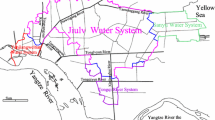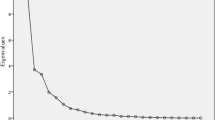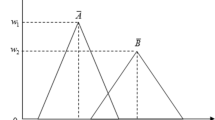Abstract
In order to reduce the losses by water pollution, forewarning model for water pollution risk based on Bayes theory was studied. This model is built upon risk indexes in complex systems, proceeding from the whole structure and its components. In this study, the principal components analysis is used to screen out index systems. Hydrological model is employed to simulate index value according to the prediction principle. Bayes theory is adopted to obtain posterior distribution by prior distribution with sample information which can make samples’ features preferably reflect and represent the totals to some extent. Forewarning level is judged on the maximum probability rule, and then local conditions for proposing management strategies that will have the effect of transforming heavy warnings to a lesser degree. This study takes Taihu Basin as an example. After forewarning model application and vertification for water pollution risk from 2000 to 2009 between the actual and simulated data, forewarning level in 2010 is given as a severe warning, which is well coincide with logistic curve. It is shown that the model is rigorous in theory with flexible method, reasonable in result with simple structure, and it has strong logic superiority and regional adaptability, providing a new way for warning water pollution risk.


Similar content being viewed by others
References
Barlow RE, Bartholomew DJ, Bremner JM et al (1972) Statistical inference under order restrictions. Wiley, New York
Chen SY (2002) Theory and application for system optimization and fuzzy recognition of the complex water resources. Jilin University, Changchun
Cheng WH, Wang CH, Zhu Y (2006) Taihu Basin model. Hohai University, Nanjing
Kelly DL, Curtis LS (2009) Bayesian inference in probabilistic risk assessment-the current state of the art original research article. Reliab Eng Syst Saf 94(2):628–643
Gabriele F, Giorgio M, Gaspare V (2010) Assessment of the integrated urban water quality model complexity through identifiability analysis. Water Res 8:1–14
He XQ (2004) Multivariate statistical analysis. China Renmin University, Beijing
Huang ZP, Chen YF (2011) Hydrological statistics. China WaterPower, Beijing
James PS (1992) Bayes statistics—principle, model and application. China Statistics, Beijing
Jixiang Z, Lizhong Z, Xiaoyuan Z et al (2012) Inverse distance weighting method in the application of the regional landslide hazard assessment. Bull soil water conserv, 32(3):9
Harisson KW (2007) Test application of Bayesian programming: adaptive water quality management under uncertainty. Adv Water Resour 30:606–622
Klas P, Georgia D (2009) Propagation of water pollution uncertainty and risk from the subsurface to the surface water system of a catchment. J Hydrol 377(3–4):434–444
Li WL (2008) Study on warning of aquatic ecological security in Bengbu. Yunnan Environ Sci 27(5):43–46
Li B (2010) Research on water resources protection and ecological construction strategy. Beijing Normal University, Beijing
Liu NL, Li MD, Zhang ZQ (2006) Forewarning and controlling system on water pollution in Jiangling River at the beginning of the research. J SiChuan Univ Sci Eng (Nat Sci Ed) 21(1):111–113
Liu Y, Yang PJ, Hu C et al (2008) Water quality modeling for load reduction under uncertainty: a Bayesian approach. Water Res 42:3305–3314
Liu SG, Lou S, Kuang CP et al (2011) Water quality assessment by pollution-index method in the coastal waters of Hebei province in western Bohai sea, China. Mar Pollut Bull 62:2220–2229
Pousada Ferradás Y, Seoane-Labandeira S, Mora-Gutierrez A et al (2012) Risk of water pollution due to ash-sludge mixtures: column trials. Int J Environ Sci Technol 9(1):21–29
Richard B, Ingemar R, Johan R et al (2009) Widespread waterborne pollution in central Swedish lakes and the Baltic Sea from pre-industrial mining and metallurgy. Environ Pollut 157:2132–2141
Su PC, Ni CJ (2004) Immune evolutionary algorithm and its application to quality assessment of water environment. J Mt Sci 22(4):439–444
Wu KY, Jin JL, Wei YM (2009) Intelligent integrated model for forewarning evaluation of watershed water security. Adv Water Sci 20(4):518–525
Yang GB, Gao YY (2006) The principle and application of fuzzy mathematics. South China University of Technology, Guangzhou
Zare Garizi A, Sheikh V, Sadoddin A (2011) Assessment of seasonal variations of chemical characteristics in surface water using multivariate statistical methods. Int J Environ Sci Technol 8(3):581–592
Zhao J (2007) Research on water resources value assessment in plain area of Taihu Basin. Hohai University, Nanjing
Zhao J (2012) Study on the risk assessment of regional flood disaster and forewarning system. Hohai University, Nanjing
Acknowledgments
The authors would like to thank the support of the Major Special Technological Program of Water Pollution Control and Management (Program No.2009ZX07106-001), the Public Welfare Industry Funding for Research and Special Projects of Ministry of Water Resources of China (No. 201301003), the National Natural Science Funds of China (No. 51079037, No. 51309072 and No. 51309004), Nanjing University of Information Science & Technology Research Foundation (S8112077001), and A Project Funded by the Priority Academic Program Development of Jiangsu Higher Education Institutions (PAPD). The authors also want to thank the anonymous referees for their helpful suggestions and corrections on the earlier draft of our paper according to which we improved the content.
Author information
Authors and Affiliations
Corresponding author
Additional information
Responsible editor: Michael Matthies
This paper is a proposed model as a tool for forewarning water pollution risk.
Rights and permissions
About this article
Cite this article
Zhao, J., Jin, J., Guo, Q. et al. Forewarning model for water pollution risk based on Bayes theory. Environ Sci Pollut Res 21, 3073–3081 (2014). https://doi.org/10.1007/s11356-013-2222-8
Received:
Accepted:
Published:
Issue Date:
DOI: https://doi.org/10.1007/s11356-013-2222-8




